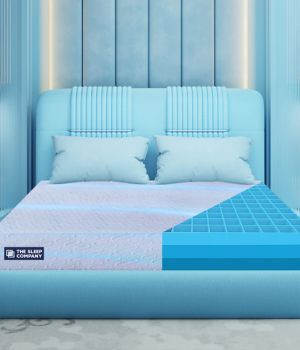views
Your sleep posture has a profound impact on your overall health from spinal alignment and muscle tension to circulation and breathing. One major factor influencing your sleep posture is the mattress you sleep on. Among the many types available, spring mattresses remain a popular choice due to their affordability, breathability, and support structure. But how does a spring mattress really affect your sleep posture? And is it the right choice for you?
This article explores the connection between spring mattresses and sleep posture, explaining how different designs support or hinder healthy sleep alignment, and what to look for when choosing the right model.
What Is Sleep Posture and Why Does It Matter?
Sleep posture refers to the position of your body while you sleep—back, side, stomach, or a combination of these. A good sleep posture:
-
Maintains the natural curve of the spine
-
Minimizes pressure on joints
-
Promotes muscle relaxation
-
Prevents chronic pain or stiffness
Poor sleep posture, especially if maintained for hours each night, can lead to neck pain, back issues, joint problems, and poor sleep quality. Your mattress plays a crucial role in either supporting or disrupting that posture.
Spring Mattresses: A Quick Overview
Spring mattresses use metal coils as their core support system. These coils may be arranged in several ways:
-
Bonnell Coils: Traditional hourglass-shaped coils connected by wires.
-
Pocket Springs: Individually wrapped coils that move independently.
-
Offset/Continuous Coils: Coils connected in rows or continuous patterns for firmer support.
The spring system is typically topped with comfort layers made of foam, fiber, or latex to cushion the body and enhance comfort.
How a Spring Mattress Affects Your Sleep Posture
1. Spinal Alignment
The most critical way a spring mattress affects sleep posture is through spinal alignment. Ideally, your spine should remain in a neutral position—neither arched nor sagging. A mattress that’s too soft may let your hips or shoulders sink too far, throwing your spine out of alignment. Conversely, a mattress that’s too firm can push against your body’s natural curves.
-
Pocket spring mattresses are best for spinal alignment, especially when paired with adaptive comfort layers. They contour to the body and reduce pressure on key areas.
-
Bonnell spring mattresses, while firm, may not adapt as well to different body types or sleeping positions, potentially leading to misalignment.
2. Support Zones
Some modern spring mattresses feature zoned support systems, offering firmer support under the hips and lower back and softer support under the shoulders and knees. These designs help keep the spine in a neutral position, especially for side and back sleepers.
This targeted support is essential for:
-
Back sleepers, who need lumbar support to prevent lower back strain.
-
Side sleepers, who benefit from pressure relief around the shoulders and hips.
-
Stomach sleepers, who need firm midsection support to avoid spinal extension.
3. Body Weight Distribution
Spring mattresses distribute body weight differently than memory foam or latex. The coil system helps lift the body rather than let it sink, which can be beneficial for:
-
Heavier individuals, who may need extra support to prevent sagging.
-
People who move frequently during sleep, as spring beds are more responsive.
However, uneven distribution due to poor-quality springs can create pressure points that distort sleep posture over time.
4. Motion Transfer and Sleep Disturbances
While this doesn’t directly impact posture, motion transfer on traditional spring mattresses (especially Bonnell coils) can cause sleep interruptions, which can force unnatural positions as you wake and shift. Pocket spring mattresses significantly reduce this issue, letting you maintain a healthy position longer without disturbance.

5. Mattress Firmness and Sleep Position
Choosing the right firmness level in a spring mattress ensures your body maintains a healthy posture throughout the night:
-
Soft to Medium-Soft: Best for side sleepers who need cushioning for hips and shoulders.
-
Medium-Firm: Ideal for most people, especially combination sleepers.
-
Firm: Best for back and stomach sleepers who need spinal support.
Spring mattresses are often on the firmer side, so layering with a quality topper may help fine-tune your ideal comfort and posture.
Common Sleep Posture Problems Caused by Poor Mattresses
A worn-out or low-quality spring mattress can create the following issues:
-
Sagging in the middle, causing spinal curvature
-
Lack of lumbar support, especially for back sleepers
-
Excess pressure on hips and shoulders for side sleepers
-
Hyperextension of the spine for stomach sleepers
If you wake up with numbness, stiffness, or back pain, your mattress might be affecting your posture.
How to Choose a Spring Mattress for Healthy Posture
Here are some tips to ensure the spring mattress you choose supports your posture:
-
Look for pocket springs with at least 600+ coils for even support.
-
Choose a zoned support system for targeted spinal alignment.
-
Check firmness level based on your sleeping position.
-
Test the mattress if possible lie in your usual sleep position and check your spine’s alignment.
-
Use ergonomic pillows to complement your mattress and maintain neck support.
Final Thoughts
Your mattress plays a vital role in maintaining a healthy sleep posture. A high-quality spring mattress especially one with pocket springs and ergonomic design can help keep your spine aligned, reduce pressure points, and promote restful, uninterrupted sleep.
Investing in the right spring mattress is more than a comfort upgrade it's a long-term investment in your spinal health, daily energy, and overall well-being. Pay attention to materials, design, and firmness to ensure that your bed supports both your body and your sleep.






















Comments
0 comment